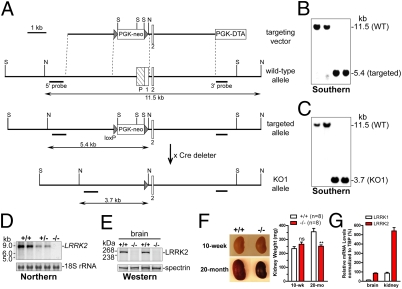Fig. 1.
Age-dependent renal atrophy in LRRK2−/− mice. (A) Targeting strategy for generation of LRRK2 KO1 mice. The locations of the 5′ and 3′ external probes used for Southern blotting are indicated. Restriction site: N, NheI; S, SphI. (B and C) Southern blotting of tail genomic DNAs using 5′ probe shows germ-line transmission of targeted allele (B) and KO1 allele (C). Tail genomic DNAs were digested with NheI. The 11.5-kb band represents the WT allele, whereas the 5.4-kb and 3.7-kb bands represent the targeted allele and KO1 allele, respectively. (D) Northern blotting of total RNAs from brains of KO1 mice shows absence and reduction of LRRK2 mRNAs in −/− and +/− mice, respectively. A 406-bp cDNA fragment spanning exons 1–5 of LRRK2 was used as a probe. 18S rRNAs were used as loading control. (E) Western blotting indicates absence of LRRK2 in the brain of −/− mice. Reprobing of the same membranes with an antibody specific for spectrin was used as loading control. (F) Compared with WT controls, kidneys (fresh, nonperfused) from 20-month-old LRRK2−/− mice are significantly smaller and darker and weigh ~30% less, whereas kidneys (perfused) from 10-week-old LRRK2−/− mice are similar in size and weight to WT controls. n = 8 Kidneys per genotypic group. (G) Quantitative RT-PCR showing relative expression levels of LRRK1 and LRRK2 mRNAs, after normalized to an internal control TATA-binding protein (TBP) mRNA, in the brain and kidney of WT mice (n = 3). All data are expressed as mean ± SEM. ns, Not significant. **P < 0.01.

